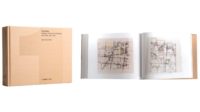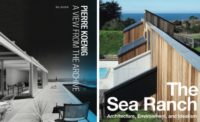New Architecture in Wood, by Marc Wilhelm Lennartz and Susanne Jacob-Freitag, translated by Philip Thrift, Birkhäuser Verlag, November 2015, 184 pages, $81.48.
Solid Wood: Case Studies in Mass Timber Architecture, Technology, and Design, by Joseph Mayo, Routledge, March 2015, 358 pages, paper, $64.95.
Two new publications make convincing arguments for timber as a viable alternative to conventional materials and methods for buildings that continue to trample the planet with giant carbon footprints. Presenting precedent-setting case studies, the authors of each demonstrate that wood is the optimal material for economically sustainable construction.
While the respective authors capture the reader’s imagination with references to picturesque timber buildings dating back hundreds of years, they do not advocate a return to the simple wood structures of yore. This organic, renewable, honest material can be engineered to exceed the limitations of the past as well as to challenge the industrialized materials of established construction. Case studies in both books demonstrate how technological innovation through engineered wood products generates bionic reinventions far removed from the primitive hut.
In Solid Wood, author Joseph Mayo, who practices architecture in the Pacific Northwest, investigated abroad the application of timber that goes beyond current building codes. He notes that architects and engineers from the subalpine regions of Austria, Germany, Switzerland, and Italy explore new wood building materials, connection systems, and fire protection techniques in converting the artisan-like craft to modern practice. Because of wood’s versatility and tactility, its architecture can express the cultural identity of various regions, which probably led to the organization of the book by country rather than building type.
In New Architecture in Wood, German authors Marc Wilhelm Lennartz and Susanne Jacob-Freitag adopt a different focus. Journalists who have closely studied this form of construction, they present their case studies by building type to show the diversity in German-speaking countries, where timber research and development occurs at the highest technical level.
Out of a combined 51 case studies, the books overlap only twice, most notably with the Woodcube project, built for the 2013 International Architecture Exhibition in Hamburg. The five-story residential building is constructed almost entirely of thick, prefabricated solid-wood elements, and adheres to stringent Passivhaus energy standards. Lennartz and Jacob-Freitag explain that Woodcube was constructed using the Austrian Thoma Holz100 system of prefabricated wall, floor, and roof components, which precluded the need for any adhesives, nails, metal fasteners, foil, or plastic sheathing in the envelope and interiors, although metal angles, bolts, and screws were necessary to secure the components to the floor slab. With 90 percent of the building made of pure timber, including exposed surfaces and structure, Woodcube is, in principle, a building made of a single material.
The slowness of the U.S. to adopt wood for large and tall structures is revealed by a paucity of North American case studies in both books. Mayo includes only the high-profile Bullitt Center designed by the Miller Hull Partnership in Seattle, praising its hypersustainability ethic as an “urban prototype.” While Lennartz and Jacob-Freitag’s book lacks North American projects entirely, they delve in detail into Konrad Wachsman’s pioneering work investigating automation and prefabrication of wood systems. As they point out, the German-born Wachsman emigrated to the U.S. after World War II and, with Walter Gropius, founded the General Panel Corporation (GPC) to produce a modular system for prefabricated timber construction.
Although engineered wood products have been used in U.S. home building for decades, the lag in scope of timber building could be shortened. The Timber Innovation Act of 2016, now working its way through Congress, promises to accelerate the use of timber in tall construction, in developing new markets, and modernizing building codes. If signed into law, it will authorize institutions of higher education to fund research into and development of longer wood spans, taller walls, and higher buildings. All parties stand to benefit markedly from such legislation. These books by Lennartz and Jacob-Freitag and by Mayo should be useful in providing American professionals with much research material for the future.




Post a comment to this article
Report Abusive Comment